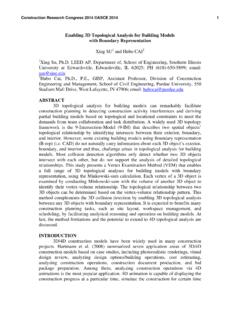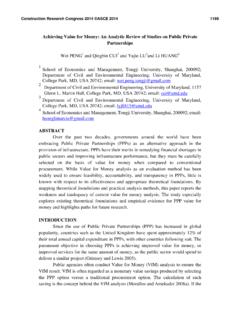Transcription of Construction Research Congress 2014 ©ASCE 2014 …
1 Developing a spatial data framework for facility management supply chain Ebrahim P. KARAN1 and Javier IRIZARRY2 1 CONECTech Laboratory, School of Building Construction , Georgia Institute of Technology, Atlanta, GA 30332; PH (404) 385-6779; FAX (404) 894-6240; email: 2 Assistant Professor, School of Building Construction , Georgia Institute of Technology, Atlanta, GA 30332; PH (404) 385-6779; FAX (404) 894-6240; email: ABSTRACT Several studies have shown that the implementation of supply chain management (SCM) in the context of facilities management (FM) can resolve service delivery problems and provide significant benefit in cost savings and customer satisfaction.
2 To fully utilize the benefits of SCM, the supply chain actors would require facilities data, suppliers information, and tools to share the information through a wide variety of users across the entire supply chain. Considering the wide range of spatial information used in the FM supply chain, this study develops a spatial data framework to manage data and disseminate information throughout a supply chain. The proposed framework uses building information modeling (BIM) capabilities to accurately provide existing information about the inside of a building and geographic information system (GIS) to support the wide range of spatial analysis used in the logistics perspective of the supply chain.
3 Also, semantic web services are used to convey meaning and support the integration of information from all of these spatial, temporal and informational dimensions. The concept of the semantic web is applied in this study to provide semantic interoperability between BIM and GIS operations and to demonstrate the feasibility of the technology for the building and FM industries. INTRODUCTION Facilities management (FM) is an integrated multidisciplinary field that covers a broad variety of services ( building maintenance, real estate management, change management, etc.)
4 And brings together a wide range of property and user related functions for the benefit of the organization and its owners/stakeholders (Lehtonen and Salonen 2005). One of the challenges facing facility managers today, particularly in the area of maintenance and repair, is the need for a system and process that delivers consistent services and solutions to their clients. A closer look at the classification of FM services from the perspective of sourcing strategy reveals how a facility manager can deploy supply chain management (SCM) solutions to resolve service delivery problems and provide significant benefit in cost savings and customer satisfaction (Lehtonen 2006).
5 FM supply chain can be defined as a system of organizations, activities, and actors on the demand side of the chain ( client, customers, users and visitors) as well as suppliers and other collaborating parties involved in the provision side of an FM service (Nelson and Alexander 2002). The implementation of SCM in the context 2355 Construction Research Congress 2014 ASCE 2014of FM can be seen as a way to deal with growing demands but constricted budgets and limited personnel. Within FM much of the supply chain is focused on maintenance, repair, and replacement services.
6 To fully utilize the benefits of SCM, the supply chain actors ( facility managers) would require facilities data ( data about inside of a building and surrounding landscape-level geospatial data), suppliers information ( location of suppliers and their financial information), and tools to share the information through a wide variety of users across the entire supply chain ( a web interface). Two-way sharing of information between both parties is crucial requirement for the implementation of SCM to facilitate the delivery of FM services.
7 Data and information sharing can be translated into frequent interactions between the FM supply chain actors, with access to precise and relevant information flow (Noor and Pitt 2009). Although the types of services that go under the umbrella of FM are varied, the spatial data that exists in a facility database is used extensively as a primary source of data. Three potential processes associated with FM that could benefit from SCM are service calls and customer service, maintenance work, and replacement services.
8 Improving data integration and visualization, as well as control in data collection are the main technology-related drivers that affect the performance of the entire FM supply chain (Scupola 2012). Considering the role of spatial information and related tools and technologies used in the FM supply chain, a spatial data framework is developed to support the sharing of geospatial data and analytical models and improve the process of decision making in management of facilities. The framework proposed in this paper uses building information modeling (BIM) capabilities to accurately provide existing information about the inside of a building and geographic information system (GIS) to support the wide range of spatial analysis used in the logistics perspective (warehousing and transportation) of the supply chain.
9 Building information models provide properties about all of the elements of the building ( identification information, maintenance information, and life-cycle condition-based information) that are inevitable components of any FM data framework. Using BIM information, it is possible to replace a part with a new one when it is out of function, preventive maintenance can be scheduled at regular time intervals, and parts can be ordered only when needed. Moreover, descriptive information ( transportation network, asset locations, etc.)
10 In GIS should be used to reduce transportation and logistics costs. The main benefits that a facility manager can expect from integrating BIM and GIS with FM are described in the following sections. BIM FOR FACILITY MANAGEMENT BIM tools provide information-rich models of the built-environment with the capability to incorporate a variety of as-built building and equipment information. The richness and reliability of the information provided by BIM allows facility managers to populate and edit the FM database in a faster and more accurate way.







